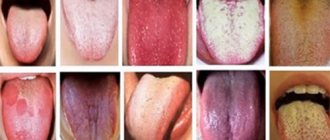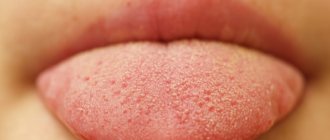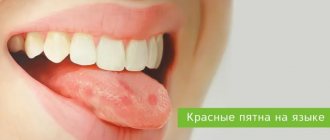If there is a sudden change in the usual appearance of the tongue, for example, when red dots or plaque appears on it, it is imperative to pay attention to this symptom, since this may be an indicator of a serious internal pathology. Many people have probably noticed that with certain diseases the nature of the surface and color of the tongue changes. This is true. This organ not only allows you to distinguish the taste of foods and talk, but also acts as a special indicator.
The tongue is normally pink in color; there may be a small amount of light coating on its root, while the rest of the surface is clean. You can also clearly see the taste buds in the form of mushroom-shaped outgrowths, and there is a clear groove in its center.
What does this mean?
The appearance of red dots on the tongue can be caused by a number of reasons, including those that do not threaten health and life. However, in some cases, such rashes indicate the appearance of a specific disease.
Red dots can have different origins:
- wound, petechiae - slight hemorrhage (with a burn of the tongue, for example);
- telangiectasia, that is, spider veins;
- ulcer;
- erosion;
- epithelial tumor of malignant and benign nature;
- rashes (macula, papule, roseola).
That is why it is of great importance to seek medical help in the case when a person finds red dots on the root of the tongue, as well as on other parts of this organ, in his child or himself.
Non-dangerous causes of appearance
The causes of red dots on the tongue that are not dangerous are:
- Eating foods colored red.
- Eating very hot or spicy food.
- Irritation or injury from wearing dentures.
- Changes in bite after visiting the dentist.
- Tongue burn.
- Allergic reaction to toothpaste and other oral hygiene products, food products.
- Smoking.
If none of the above explanations are found in a person, it is necessary to look for reasons of a more serious nature. The most common ones should be considered.
Why do red dots appear?
Red dots on the tongue most often appear with stomatitis (inflammatory processes of the oral mucosa). There are quite a few direct causes of the development of stomatitis, but most often it is a viral infection, for example, of a herpetic nature.
Other factors also include pathogenic bacteria (streptococci, staphylococci), poor nutrition, fungi (for example, candidiasis), thermal or mechanical injuries, side effects of a number of medications, anemia, hormonal imbalance, decreased salivation, and dehydration.
The next common cause of red dots is allergies. It most often differs in food origin. You can suspect it when keeping a food diary. In this case, it is convenient to note the relationship between the appearance of a rash and the use of a specific product.
What are the reasons for red dots and white coating on the tongue? More on this below.
Burning tongue: treatment methods
After diagnosing and establishing the cause of burning tongue, the doctor prescribes appropriate treatment. The extent of therapeutic intervention mainly depends on the underlying cause of the symptom. For this symptom, the following treatment options are used:
- Analgesic, symptomatic treatment . Anesthetic drugs are used for these purposes.
- Antibacterial therapy . Prescribed when a bacterial infection of the oral cavity is detected.
- Treatment at the dentist . The patient is given a set of therapeutic measures to eliminate caries, pulpitis, gingivitis, periodontitis and other dental diseases.
- Antifungal therapy . It is used for fungal infections of the oral cavity (candidiasis).
- Treatment of diabetes mellitus . Antihyperglycemic drugs are prescribed, as well as a special diet that limits the consumption of simple carbohydrates.
- Antiallergic treatment . Used for allergic reactions. The most effective way in this case is to avoid contact with the allergen. And to relieve an allergic reaction, antihistamines are used.
- Treatment of neurological and mental disorders . Depending on the root cause of the burning sensation in the mouth, the patient is prescribed antiepileptic drugs, antidepressants and other drugs that improve the functioning of the nervous system.
- Psychotherapy. Sometimes psychotherapy helps with this symptom. In particular, this works if the symptom is associated with increased stress levels or a mental health disorder.
- Other types of treatment . An individual treatment regimen is selected for each patient.
Home methods and traditional medicine
To treat this symptom, various traditional medicines are used that have a calming effect on the oral mucosa. Let's look at the most popular means:
- Rinsing with decoctions of medicinal plants . For these purposes, sage, chamomile flowers, aloe, linden flowers and other medicinal plants that have a calming effect are used.
- Rinsing the mouth with a salt solution . Salt has a mild anti-inflammatory and anti-edematous effect.
- Sucking ice cubes . This procedure will not only soothe the “burning” tongue, but also strengthen the throat.
To maintain oral health, it is important to drink enough fluids. This will avoid dry mouth and a number of problems that are associated with this circumstance (in particular, oral infections).
Mononucleosis
Rashes in the form of red dots on a child’s tongue may indicate the appearance of infectious mononucleosis, that is, an acute viral disease that is provoked by the Epstein-Barr virus.
Petechiae and telangiectasias on the surface of the tongue may indicate diseases of the circulatory system (thrombocytopathy, thrombocytopenia), vascular pathologies (vasculitis), liver diseases (organ failure, cirrhosis, hepatitis).
In some cases, a red dot on the surface of the tongue or under it is a symptom of quite rare diseases, for example, Kaposi's sarcoma, Kawasaki syndrome, tumors and pernicious anemia.
What does the tongue say about our health?
The tongue is often called the mirror of our body. Any disturbances in the body are reflected on the surface of the tongue. An external examination of your tongue can tell you whether you are getting enough nutrients and whether you have any digestive problems. Tongue color and texture are important indicators of health problems.
Stand in front of a mirror, open your mouth and stick out your tongue. If it is pink in color with a rough surface, then you are absolutely healthy. With age, the human body ages and health becomes worse, which is reflected in the language. The tongue is an indicator of human health; the state of the tongue can determine the problems occurring in our body.
What does the color of the tongue say?
- Burgundy - infectious diseases
- Pale - heart problems, poor diet
- Yellow - problems with the gastrointestinal tract
- Purple – diseases of the respiratory system
- Gray - indicates the accumulation of bacteria in the grooves of the taste buds
- Black - indicates weakness of the liver and spleen, dysentery, serious viral infections and even abscesses
- Blue - indicates kidney disease
- White is a sign of oral candidiasis, a fungal infection in the mouth
- Bluish - indicates poor blood circulation, scurvy and heavy metal poisoning, especially mercury
- Brown - indicates bleeding in the mouth.
What does the color of plaque on the tongue indicate?
- White plaque is the most common phenomenon in our language. It can be of different nature, it can cover the entire tongue, or it can be located in islands. A light white coating is present on the tongue of a healthy person. Various degrees and forms of white plaque indicate the penetration of infection into the body. As the disease spreads and intensifies, the white coating will gradually thicken and acquire darker shades.
- A yellow tint indicates diseases of the gastrointestinal tract or liver. The rule also applies here - the lighter the plaque, the earlier the stage of the disease. Light yellowness of the plaque in hot weather is considered normal.
- Gray or black plaque - formed as a result of darkening of the white plaque during an exacerbation of the disease or as a result of a chronic disease. The transformation of gray plaque into black will indicate a critical stage of the disease.
- Brown plaque indicates severe or chronic gastrointestinal diseases, as well as lung diseases.
- Greenish-brown plaque - occurs as a result of excess bile in the body against the background of problems with the liver or gallbladder.
- Purple plaque indicates blood stagnation.
- A bluish coating appears with diseases such as dysentery or typhoid.
Signs of internal organs on the tongue.
Traditional Chinese medicine associates certain areas of the tongue with various internal organs. Therefore, disturbances in the functioning of any organ may manifest themselves in the language area associated with this organ. The front of the tongue is a mirror image of the liver, heart and lungs, the middle shows the stomach, pancreas and spleen. Sections of the intestine can be diagnosed by the root of the tongue, but the kidneys can be diagnosed by the lateral sections of the tongue. Various changes in the ulcer, redness of plaque in these projections, indicate one or another pathology of the corresponding organ.
- The tip of the tongue is the heart
Persistent redness close to the tip of the tongue may indicate heart problems. Also, a tongue with a red tip can be a sign of emotional trauma.
- Central part of the tongue - stomach, spleen
A yellow coating on the central part of the tongue indicates problems with digestion, and that there may be something wrong with the stomach, pancreas or spleen.
- Sides of the tongue - liver
The appearance of teeth marks on the sides of the tongue is interpreted as a sign of poor nutrient absorption and may indicate liver problems such as liver enlargement or hepatitis. Bluish-greenish spots on the sides of the tongue can also reflect liver diseases such as cirrhosis.
- The area behind the tip of the tongue is the respiratory system
Red spots on the area of the tongue just behind the tip may indicate lung problems such as pneumonia and asthma. A foam on the front of the tongue can be a sign of congestion in the chest and lungs, and indicate bronchitis and respiratory allergies.
- Back of the tongue – kidneys, intestines
A thick yellow coating on the back (at the base of the tongue) indicates bladder problems and susceptibility to kidney stones and even kidney failure.
All of the above signals from our body for the presence of various diseases require immediate attention to specialists. And one more thing - you need to examine the tongue when it is clean. It can be tidied up with a special tongue massager, which is sold in a pharmacy, or with a soft toothbrush.
Red dots on the tongue and white coating
In some cases, the appearance of red dots is also accompanied by a yellowish or white coating, which is expressed to a certain extent. When it appears on the root of the tongue, the doctor will most likely discover intestinal or stomach pathologies in the patient. These may include, for example, chronic gastritis. In this case, the therapist will most likely refer the patient to a gastroenterologist.
A tongue covered with a white coating and red dots is often accompanied by bad breath. In this case, the cause could be her illness (for example, stomatitis) or diseases of the intestines and stomach. In some cases, the source of pathological signs is insufficient oral hygiene, so you need to brush your teeth on time and use rinses after meals.
How to remove
If a patient has a brown plaque, treatment should be aimed at eliminating the cause that causes it. First, you need to thoroughly clean your teeth, gums, inner surface of your cheeks and tongue from plaque using a toothbrush and toothpaste. Next, you should observe whether the plaque appears again and, if so, how quickly. And depending on the result obtained, whether or not to consult a doctor. If, after careful hygiene procedures, the plaque disappeared and did not appear again, then it was most likely the result of staining with food or medicine. In this case, there is no reason for alarm or treatment.
But if plaque appears again and again, is difficult to remove, and stays on the tongue for longer than five days, then this is a serious reason to consult a gastroenterologist, since a brown tongue primarily indicates problems with the gastrointestinal tract.
Rinsing the mouth with a decoction of chamomile or calendula flowers will help you deal directly with plaque. You can also chew a small piece of propolis for a few minutes; it has excellent bactericidal properties.
And remember: if the reason that caused the formation of a brown coating on the tongue is eliminated, it will disappear on its own without any measures within a few days. Therefore, you should fight the cause that causes it.
Pale tongue tone
Also, red dots on the tip of the tongue without plaque occur with anemia, but the organ itself turns pale, which is very easy to confuse with deposits. When detecting spots on the tongue, a person does not need to immediately worry and panic. First, you should observe your own condition and check whether such spots disappear within a few days. If there are no changes, even after adjusting the diet and the absence of bad habits, it is advisable to still go to see a doctor and take all the tests required to diagnose the disease, as well as undergo an examination.
Features of treatment
Barring allergies, trauma and dyes, it is very important to treat permanent stains correctly. You need to go to an appointment with a dentist, who will treat, for example, glossitis, herpes, stomatitis, and identify benign formations in the oral cavity. If the disease is not dental, then he will refer you to a general practitioner, pediatrician, oncologist, cardiologist and gastroenterologist. Specialists may need additional examinations and tests. You cannot self-medicate.
These could be, for example, cancers that require long and serious treatment, as well as earlier diagnosis. Spots caused by pathologies of the gastrointestinal tract and hematopoietic system are treated only when the cause of their appearance is addressed. A hematologist or gastroenterologist can determine it after examination. This disease cannot be dealt with at home; it will only waste time. To get rid of pyogenic granuloma, specialists will prescribe surgery, cryodestruction or electrocoagulation. How else to treat red dots on the tongue?
They try to treat candidiasis on their own with decoctions, rinses, infusions and other folk remedies. Sometimes that's enough. However, most often you need to take antifungal agents internally, as well as immunomodulators and vitamins to strengthen the body as a whole.
Leukoplakia can be cured by dental treatment or elimination of foods with sharp edges from the diet. If the reddened part of the tongue is covered with keratinized grains, this indicates the beginning of a precancerous condition. In this case, you need to contact an oncologist. A “geographical” or “bald” tongue cannot be returned to its former state, since the taste buds and papillae cannot be restored. Allergic reactions in the form of redness occur in children and are difficult to treat if several new foods are introduced into the diet at the same time. Red food is a particular allergen.
Treatment
Treatment of red spots on the tongue involves eliminating the provoking factor. If you have bad habits that caused the phenomenon in question, you need to give them up. It is important not to rub the red spots during treatment. This leads to the formation of open wounds on the surface of the tongue, which can lead to infection of the body.
Self-medication is dangerous with complications!
Attention
Despite the fact that our articles are based on trusted sources and have been tested by practicing doctors, the same symptoms can be signs of different diseases, and the disease may not proceed according to the textbook.
Pros of seeing a doctor:
- Only a specialist will prescribe suitable medications.
- Recovery will be easier and faster.
- The doctor will monitor the course of the disease and help avoid complications.
find a doctor
Do not try to treat yourself - consult a specialist.
Therapy for candidiasis involves taking antifungal drugs and immunomodulators. Additionally, vitamin complexes are prescribed and the oral cavity is treated with antiseptic substances.
If the tongue turns red due to an allergic reaction of the body, it is important to eliminate the influence of the provoking factor: stop taking medications, stop consuming certain foods.
Antihistamines are used to suppress the main symptoms. If necessary, therapy is supplemented with corticosteroids and vitamin complexes.
The treatment of herpes zoster uses a comprehensive approach, including the simultaneous use of antibacterial and antiviral drugs. To eliminate sarcoma, a consultation at the oncology center is necessary. Such a tumor is eliminated through chemotherapy.
If you suspect diseases of the gastrointestinal tract, it is recommended to adjust your diet by excluding spicy and smoked foods. In addition to these measures, the immune system should be strengthened.
If dense spots are detected on the surface of the tongue, the patient is sent for examination to a dermatovenerologist. If the latter confirms the presence of syphilis, appropriate therapy is carried out.
Stomatitis and other similar diseases can be cured through regular oral treatment prescribed by a dentist.
Prevention
To avoid the reappearance of small red dots on the tongue, you must carefully follow a number of recommendations:
- Eliminating bad habits.
- Scrupulous personal hygiene of the oral cavity, as well as good quality toothpaste and brushes.
- Review your diet and get rid of fast food products that are rich in hot spices.
- Carbonated drinks should not be consumed, especially if they contain a large number of dyes.
- Strengthening the immune system.
- Periodic visits to the doctor.
- It is recommended to harden children, carefully choose a diet, and also exclude the intake of any allergen.











